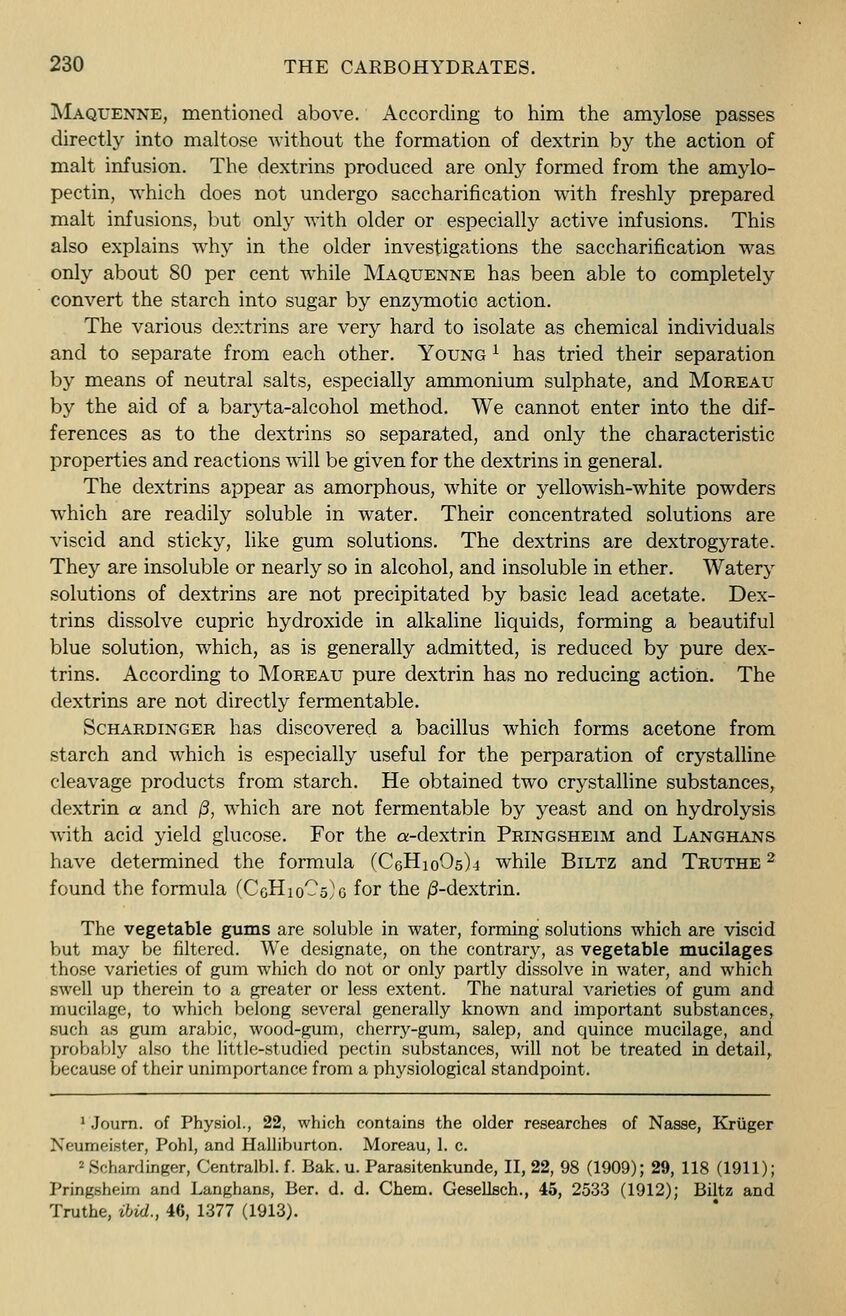
Full resolution (JPEG) - On this page / på denna sida - III. The Carbohydrates - 3. Colloid Polysaccharides - Dextrins and Gums

<< prev. page << föreg. sida << >> nästa sida >> next page >>
Below is the raw OCR text
from the above scanned image.
Do you see an error? Proofread the page now!
Här nedan syns maskintolkade texten från faksimilbilden ovan.
Ser du något fel? Korrekturläs sidan nu!
This page has never been proofread. / Denna sida har aldrig korrekturlästs.
230 THE CARBOHYDRATES.
Maquenne, mentioned above. According to him the amylose passes
directly into maltose without the formation of dextrin by the action of
malt infusion. The dextrins produced are only formed from the amylo-
pectin, which does not undergo saccharification with freshly prepared
malt infusions, but only with older or especially active infusions. This
also explains why in the older investigations the saccharification was
only about 80 per cent while Maquenne has been able to completely
convert the starch into sugar by enzymotic action.
The various dextrins are very hard to isolate as chemical individuals
and to separate from each other. Young i
has tried their separation
by means of neutral salts, especially ammonium sulphate, and Moreau
by the aid of a baryta-alcohol method. We cannot enter into the dif-
ferences as to the dextrins so separated, and only the characteristic
properties and reactions will be given for the dextrins in general.
The dextrins appear as amorphous, white or yellowish-white powders
which are readily soluble in water. Their concentrated solutions are
viscid and sticky, like gum solutions. The dextrins are dextrogyrate.
They are insoluble or nearly so in alcohol, and insoluble in ether. Watery
solutions of dextrins are not precipitated by basic lead acetate. Dex-
trins dissolve cupric hydroxide in alkaline liquids, forming a beautiful
blue solution, which, as is generally admitted, is reduced by pure dex-
trins. According to Moreau pure dextrin has no reducing action. The
dextrins are not directly fermentable.
Schardinger has discovered a bacillus which forms acetone from
starch and which is especially useful for the perparation of crystalline
cleavage products from starch. He obtained two crystalline substances,
dextrin a and f3, which are not fermentable by yeast and on hydrolysis
with acid yield glucose. For the a-dextrin Pringsheim and Langhans
have determined the formula (CeHinOs^ while Biltz and Truthe 2
found the formula (CgHioCs^g for the /3-dextrin.
The vegetable gums are soluble in water, forming solutions which are viscid
but may be filtered. We designate, on the contrary, as vegetable mucilages
those varieties of gum which do not or only partly dissolve in water, and which
swell up therein to a greater or less extent. The natural varieties of gum and
mucilage, to which belong several generally known and important substances,
such as gum arabic, wood-gum, cherry-gum, salep, and quince mucilage, and
probably also the little-studied pectin substances, will not be treated in detail,
because of their unimportance from a physiological standpoint.
1
Journ. of Physiol., 22, which contains the older researches of Nasse, Kriiger
Neumeister, Pohl, and Halliburton. Moreau, 1. c.
-
Schardinger, Centralbl. f. Bak. u. Parasitenkunde, II, 22, 98 (1909); 29, 118 (1911);
Pringsheim and Langhans, Ber. d. d. Chem. Gesellsch., 45, 2533 (1912); Biltz and
Truthe, ibid., 46, 1377 (1913).
<< prev. page << föreg. sida << >> nästa sida >> next page >>